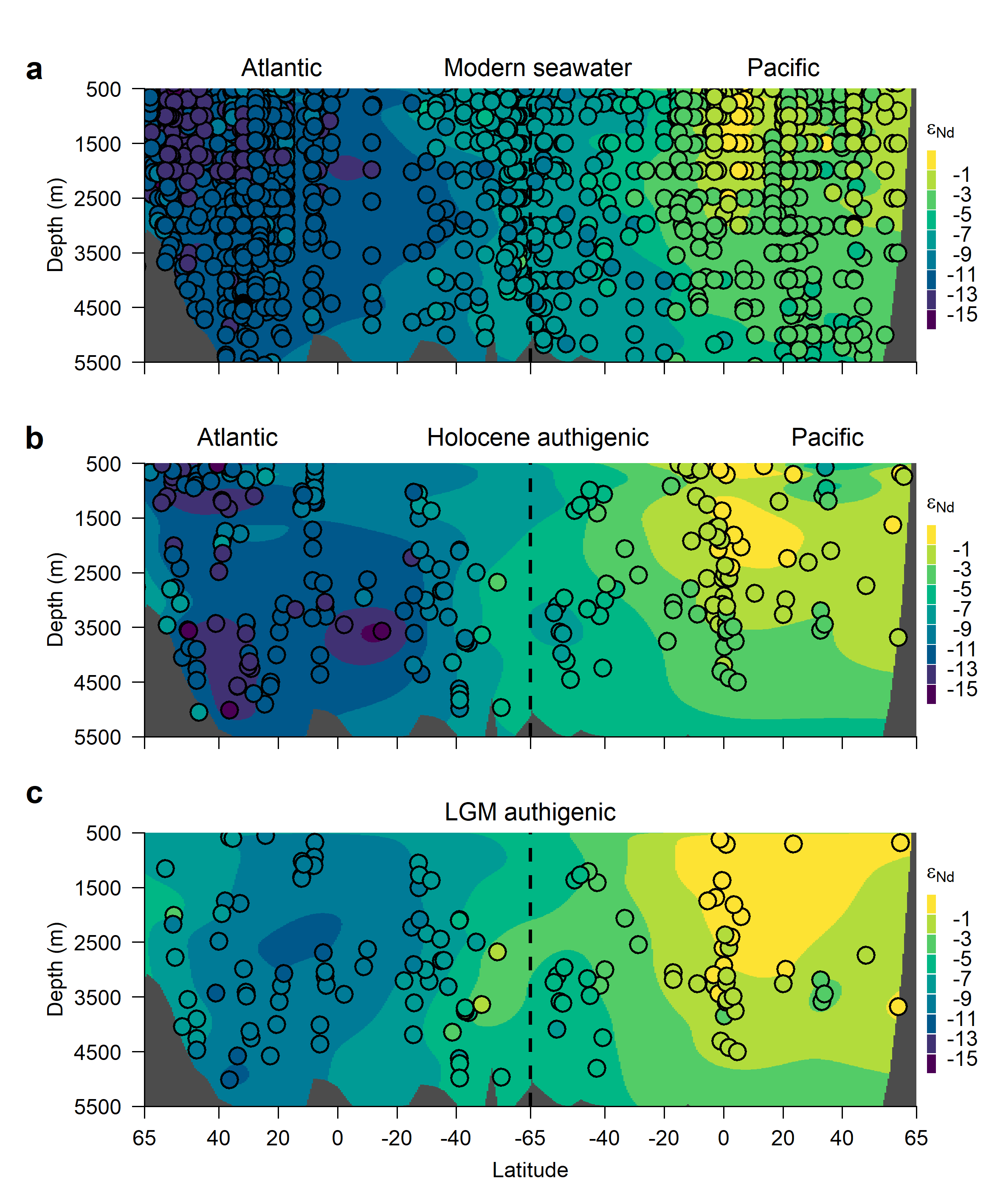Related Links
Description
Isotopes of the rare earth element Neodymium (Nd) have been proposed as a tracer of past ocean circulation. However, the processes that determine the distribution of Nd isotopes in the modern ocean are still not well understood. Most previous work has assumed exchange of Nd in bottom water with sediments along shallow continental boundaries, which varies in their isotopic signature because of the age of the continental crust, but ocean models applying this process have difficulties reproducing observed distributions of Nd isotopes in today's ocean. The figure below shows that observations indicate more negative (less radiogenic) values of εNd in the Pacific, reflecting younger continental crust (Ring of Fire) and more positive (more radiogenic) values in the Atlantic, reflecting the older continental crust there.

Observations of εNd. Latitude-depth sections through the Atlantic (left) and Pacific (right) of modern sea water εNd (top), Holocene authigenic εNd (center) and LGM authigenic (bottom). From Du et al. (2020).
Here we will conduct a comprehensive computer modeling study testing a new idea: the bottom-up hypothesis, which suggests input of Nd from deep sea sediments to the water column everywhere in the ocean, including the deep abyssal plains far away from continents. Model results will be compared to measurements from the international GEOTRACES program. Implications of the hypothesis to enable estimates of bottom water flow speeds will be explored through simulations of the ocean during the last ice age. This study may transform our ability to reconstruct deep circulation in past oceans, which is important to better understand cycling of carbon and other biologically and climatically important elements. A model description paper, webinars, and a cross-disciplinary workshop will benefit the larger ocean sciences community. Early-career scientists, graduate and undergraduate students will be supported.
Nd isotopes will be implemented in an established global three-dimensional model of ocean circulation and biogeochemistry. Structurally different model versions will be generated to explore the roles of scavenging, boundary exchange and benthic flux on dissolved and particulate Nd isotope distributions. New measurements of surface sediment Nd isotopes will fill gaps in the existing database, which will be used to model the isotopic composition of the benthic flux. Models will be comprehensively evaluated with GEOTRACES observations to test the hypothesis that a ubiquitous flux of Nd along the sea floor is the dominant source of Nd in the water column. Previous studies assume exchange only along upper ocean margins and conservative behavior in the interior, which suggests Nd isotopes are a water mass tracer without rate information. In contrast, the benthic flux hypothesis implies abyssal flow rate to be an important influence on Nd isotopes. This suggests that Nd isotope measurements from sediments could be used to infer rates of bottom water flow and the abyssal overturning circulation rate. Simulations of the Last Glacial Maximum (~20,000 years ago) ocean will test this idea and evaluate the ability to use Nd isotopes to reconstruct abyssal circulation.
For more details see the Project Description and References documents.
Jointly funded by
the National Science Foundation's Chemical Oceanography and Marine Geology and Geophysics Programs
Publications
Evaluation of the University of Victoria Earth System Climate Model version 2.10 (UVic ESCM 2.10)
Evolution of the Global Overturning Circulation since the Last Glacial Maximum based on marine authigenic neodymium isotopes
People
- Andreas Schmittner, Principle Investigator
- Brian Haley, Co-PI
- Jianghui Du, Collaborator
- Samar Khatiwala, Collaborator